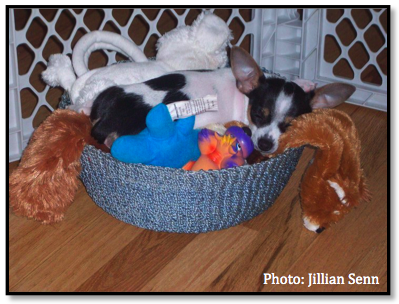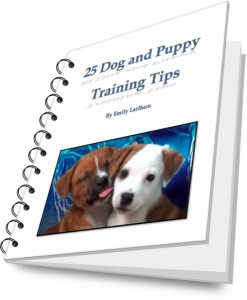By Emily Larlham
1 Leave your dog alone while you are home
 This teaches the dog to enjoy being alone while it is not associated only with you leaving the house. You can use baby gates and pens to keep your dog in one part of the house while you are in another. You can give your dog food puzzles, chews, and hide treats for your dog to find while you are in another part of the house to make the alone time highly reinforcing.
This teaches the dog to enjoy being alone while it is not associated only with you leaving the house. You can use baby gates and pens to keep your dog in one part of the house while you are in another. You can give your dog food puzzles, chews, and hide treats for your dog to find while you are in another part of the house to make the alone time highly reinforcing.
2 Never let your dog know if you are home or not when leaving your dog alone
If you have a severely anxious dog, you can keep your dog in one part of the house and play music outside the room so your dog cannot focus on the sounds you make and deduce from them whether you are home or not. In conjunction with this, you can also repeatedly open and close doors loudly and go in and out of the front door so that your dog never knows whether you are in the house or not.
3 Leave your dog when your dog has just settled
 It’s a good idea to let your dog settle down before you leave your dog, if you are still working on separation training. If you take your dog out to pee, do a training session, or play with him just before you leave the house, it could actually cause your dog to be more stressed when you leave him. This is because there becomes a huge contrast between what it’s like when you are home and when you are gone. Instead, wait a couple minutes for your dog to settle down before leaving.
It’s a good idea to let your dog settle down before you leave your dog, if you are still working on separation training. If you take your dog out to pee, do a training session, or play with him just before you leave the house, it could actually cause your dog to be more stressed when you leave him. This is because there becomes a huge contrast between what it’s like when you are home and when you are gone. Instead, wait a couple minutes for your dog to settle down before leaving.
4 Make sure to give your dog enough mental and physical exercise
Dogs sleep most of the day. If you give your dog mental and physical stimulation before you leave for work, the dog will be more likely to want to sleep during the time that you are away. When a dog doesn’t get enough exercise, the dog will be more likely to be awake and looking for things to do in your absence.
5 Experiment with what makes your dog feel more comfortable
For some dogs, less room to roam when home alone makes them more comfortable, while others feel more comfortable with more space. Some dogs find the TV or radio on soothing, while others find it more stressful. You can also experiment with using a Dog Appeasing Pheromone collar or spray, as well as other herbal remedies. I have seen natural remedies have both extreme effects as well as what seems like no effect whatsoever.
6 Spy on your dog
Spy on your dog or Skype your dog using modern technology while your dog is “alone” for the first time with free range to your stuff. Even if your dog might learn that he can make you “come back” that one time you rush in, it will stop the dog from practicing and finding destructive behavior like destroying your $5,000 couch reinforcing in your absence. It’s easier to go back a step in your separation training plan, but not so easy to teach your dog not to eat your house when you are not around to stop him.
7 Dogs need choices
 I recommend teaching your dog to like being in a crate for many beneficial reasons, however being left alone during the day is not one of them. I believe that dogs need to make choices throughout the day and only being able to lie down and turn around when inside a create can cause behavioral side effects.
I recommend teaching your dog to like being in a crate for many beneficial reasons, however being left alone during the day is not one of them. I believe that dogs need to make choices throughout the day and only being able to lie down and turn around when inside a create can cause behavioral side effects.
Instead of using a crate for alone time, if you have a dog that could potentially be destructive, you can create a safe pen for your dog to stay in or create a dog-safe room.
Here is a blog on how to create an escape-proof exercise pen:
http://clicktreat.blogspot.se/2009/06/making-escape-proof-x-pen.html
8 Don’t pay attention to your dog when leaving or arriving
Don’t make leaving or coming home of such importance to your dog. Your dog should want to keep dozing in the sun as you exit to go off to work, not jump up and start to panic.
For dogs that are anxious about being alone, we need to put our own desires of wanting a happy greeting on our arrival home or a snuggle on our departure aside and concentrate on building a calm and more independent dog. To help your dog to be more independent, ignore him upon entering and leaving your house or the room your dog is in. You can save your hellos for later. For example, half an hour after returning you can get down on your knees and excite your dog as much as your want. By putting time between when you come home and when you lavish attention on your dog, you will not create a huge contrast between the time your dog spent alone and when you walk through the door.
In my opinion, dogs are highly intelligent beings and are conscious of whether they are being looked at or not, in a similar way to how people are. Imagine you are looking through the window at someone on the street, and do not feel self-aware. Suddenly, the person on the street looks through the window and stares at you. This immediately makes you feel self-aware.
Now I do not now if this happens to dogs, but in my humble opinion I feel it could be possible. In theory, if your dog is sitting in a pen in a room, and if you walk around the room and pretend you cannot see your dog, your dog will be less anxious than if you make eye contact with your dog. When working on separation training, pretend your dog is invisible. Even when you go over to drop a treat into your dog’s pen, or let the dog out, try to pretend you cannot see the dog as you are doing it. Obviously do not always pretend you cannot see your dog. Just do it when you think looking at your dog will make him overly excited.
9 Try medication for severe anxiety
If you have a severely anxious dog and you have tried everything you possibly can, visit your vet to see if your dog might benefit from medication. The point of giving the medication would be to get your dog calm enough to train your dog and then wean the dog off the medication as soon as possible.
Here is a video tutorial on the first steps of training your new dog or puppy to be left alone in a pen:
25 Dog and Puppy Training Tips:
For each month of the year, I will release 2 training tips that will be accessible for free at dogmantics.com. If you simply cannot wait for the information to be published online, you can buy the collection of all 25 training tips in an ebook format here: 25 Dog and Puppy Training Tips
This is a list of all the tips included in the ebook, and that will be eventually available online:
- Teaching a dog previously kept outside to be calm inside the house
- The problem with ignoring unwanted behaviors
- Fading a lure
- Adding a verbal cue or changing a cue
- Dogs and babies
- Socializing tips- Our world can be a scary place!
- What to do if your puppy bites you OUTSIDE of a training session
- Changing your thinking from “I don’t like” to “I need to work on”
- What to use as reinforcement
- Treat deliveries
- Teaching your puppy appropriate greetings on leash
- Teaching “All done” for training sessions and dinnertime manners
- Variety is the spice of life… and training!
- Teaching your puppy to walk off leash
- Don’t let your dog free feed
- Don’t only work on one behavior at a time
- Separation training tips
- Monkey see, monkey do- Take advantage of social facilitation
- Always remember to release your dog!
- The importance of handling
- Chewing
- Teaching “Drop” and “Get it”
- What to do if your puppy sits and refuses to budge on a walk
- Generalizing
- Training your dog to do absolutely… NOTHING!
